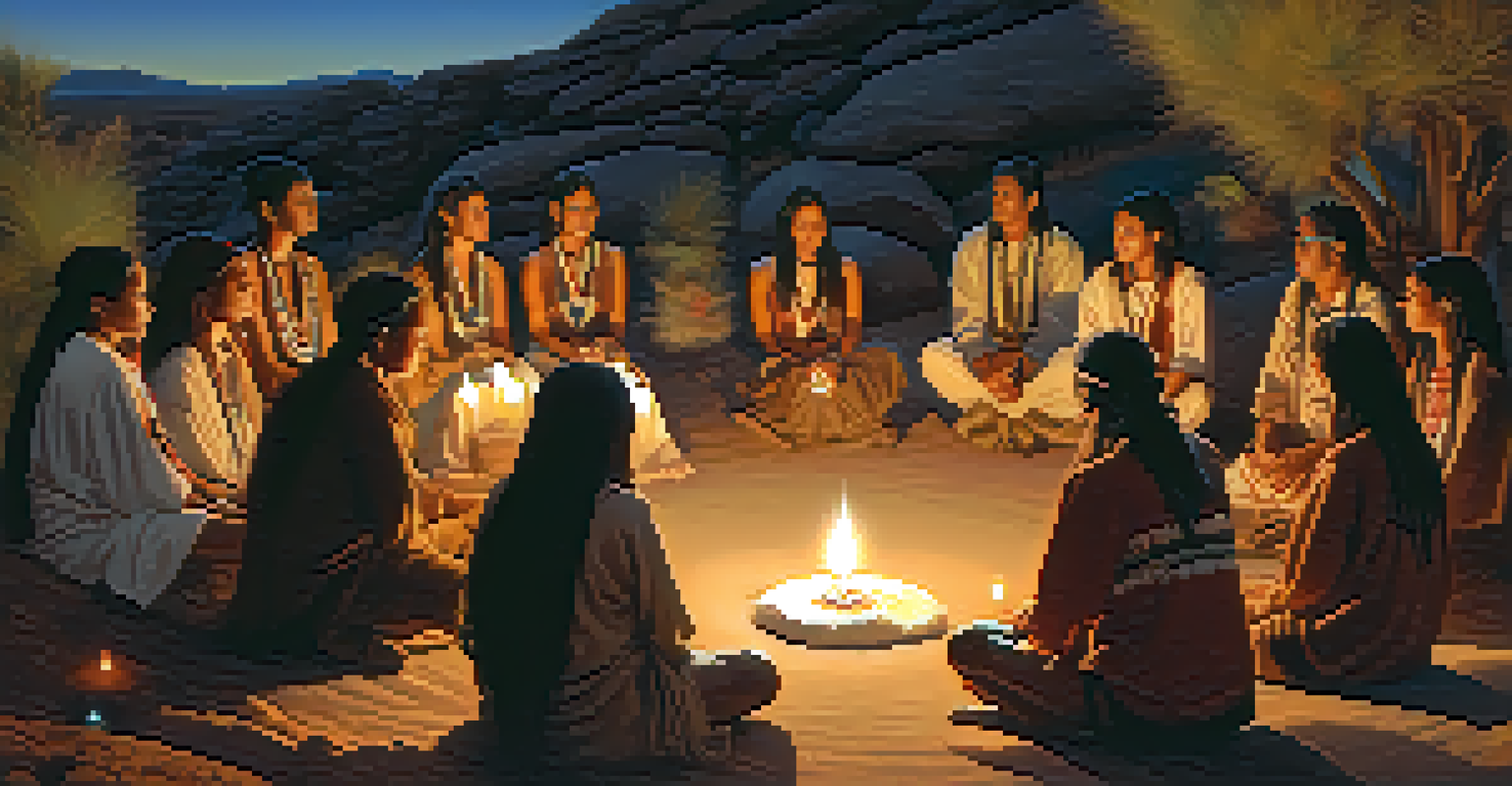Temporal Experiences in Peyote Ceremonies: A Psychological View

Understanding Peyote and Its Cultural Significance
Peyote, a small cactus containing the psychoactive compound mescaline, has been used for centuries in Native American spiritual practices. Its significance extends beyond mere consumption; it plays a central role in rituals aimed at healing and spiritual awakening. In these ceremonies, participants often seek to connect with the divine, experience profound insights, and understand their place in the universe.
The experience of time is a fluid concept, especially in altered states of consciousness where the past, present, and future can intertwine.
The cultural importance of peyote is deeply intertwined with the identity of various tribes, particularly the Huichol and the Navajo. These ceremonies are not just about the substance; they embody traditions, community bonds, and a shared quest for knowledge. As such, understanding peyote requires an appreciation of its historical and spiritual context.
In the face of modern challenges, these ceremonies offer a refuge and a way to reconnect with age-old wisdom. By exploring the psychological experiences during these rituals, we can better understand how time perception shifts and evolves, reflecting the transformative nature of peyote.
The Nature of Temporal Experiences in Ceremonies
Temporal experiences refer to how individuals perceive and process the passage of time, which can dramatically alter during peyote ceremonies. Participants often report a sense of timelessness or the feeling that time has expanded or contracted, leading to a unique psychological state. This distortion can heighten emotional and spiritual experiences, creating a profound sense of connection with the moment.

For instance, many participants describe feeling as though hours have passed within minutes, or conversely, that they have experienced a lifetime within a brief session. These altered states may allow deeper introspection and facilitate emotional healing, as individuals confront their thoughts and feelings without the usual constraints of time pressure. This phenomenon is not only fascinating but also crucial for understanding the therapeutic potential of such experiences.
Peyote's Spiritual and Cultural Role
Peyote is central to Native American rituals, facilitating healing and spiritual awakening through community and tradition.
Moreover, the communal aspect of these ceremonies enhances the perception of time. Shared experiences can create a collective temporal flow where the boundaries of individual experiences blur, fostering a deep sense of unity and belonging among participants. This shared journey can significantly impact their psychological well-being and sense of self.
Psychological Mechanisms Behind Temporal Perception
The psychological mechanisms that underlie temporal perception during peyote ceremonies are complex and multifaceted. Factors such as altered brain chemistry, heightened emotional states, and focused attention contribute to these unique experiences. Mescaline, the active compound in peyote, influences neurotransmitters that modulate mood and perception, leading to shifts in how time is experienced.
In the midst of chaos, there is also opportunity; the journey through altered time can lead to profound personal transformation.
In addition to chemical influences, the rituals surrounding peyote consumption play a crucial role. The structured environment, guided by experienced facilitators, helps participants focus their thoughts and intentions, which can amplify the effects of peyote. This intentionality can further alter their perception of time, making each moment feel more significant.
Furthermore, psychological theories suggest that our perception of time is closely linked to memory and attention. During intense emotional experiences, like those often encountered in peyote ceremonies, the brain processes information differently, resulting in vivid memories that can make time feel elongated. Understanding these mechanisms not only sheds light on peyote experiences but also on broader human psychology.
Case Studies: Personal Accounts of Time Distortion
To appreciate the psychological nuances of temporal experiences in peyote ceremonies, we can look at personal accounts from participants. Many describe their journey as a 'time warp,' where past, present, and future intermingle, allowing for profound insights and clarity. One participant recounted feeling as if they had revisited pivotal moments in their life, providing a deeper understanding of their choices and emotions.
Another account highlighted the sensation of floating through time, where the boundaries of the ceremony felt limitless. This individual expressed feeling a connection with ancestral spirits, as if time itself became a bridge to the past. Such narratives not only emphasize the subjective nature of time but also illustrate the potential for personal transformation.
Temporal Experience in Ceremonies
Participants often report altered perceptions of time during peyote ceremonies, enhancing emotional and spiritual experiences.
These case studies reveal the profound impact of peyote on cognitive and emotional processes, showcasing how altered time perception can lead to significant psychological shifts. By examining these experiences, we gain insight into the therapeutic potential of such ceremonies in addressing mental health and personal growth.
The Role of Setting and Intention in Temporal Experiences
The setting and intention behind peyote ceremonies are crucial elements that influence participants' temporal experiences. A carefully curated environment that fosters safety, connection, and openness can enhance the depth of these experiences. When individuals enter a space designed for introspection and spirituality, their perception of time may shift even more dramatically.
Intention also plays a significant role; participants who approach the ceremony with clear objectives—be it healing, understanding, or spiritual connection—often find their experiences more meaningful. When intention aligns with the collective energy of the group, the sense of time can feel fluid, allowing participants to immerse themselves fully in the moment.
This interplay between setting and intention not only enhances the psychological experience but also underscores the importance of context in altered states of consciousness. By creating a conducive environment and fostering a shared purpose, the potential for transformative temporal experiences increases, highlighting the power of peyote ceremonies.
Comparative Perspectives: Peyote and Other Psychedelics
While peyote offers a unique lens on temporal experiences, it’s interesting to compare it with other psychedelics such as psilocybin and LSD. Each substance can induce altered states of consciousness, yet the specific experiences of time perception can vary greatly. For instance, users of psilocybin often report a sense of eternity, while LSD may lead to rapid time shifts that feel more fragmented.
These differences can largely be attributed to the unique ways each substance interacts with the brain's neurotransmitter systems. Peyote’s connection to cultural and spiritual practices may also amplify its effects on time perception, creating a more cohesive and profound experience compared to other psychedelics. This highlights the significance of context in shaping the psychological outcomes of these substances.
Therapeutic Potential of Peyote
Understanding temporal experiences in peyote ceremonies can inform therapeutic practices, aiding those with mental health challenges.
Exploring these comparative perspectives enriches our understanding of how psychedelics can influence human consciousness. By recognizing the distinct characteristics of each substance, we can better appreciate the diverse range of experiences that contribute to our knowledge of time perception in altered states.
Implications for Mental Health and Therapeutic Practices
The insights gained from understanding temporal experiences in peyote ceremonies have significant implications for mental health and therapeutic practices. Many individuals struggling with anxiety, depression, or trauma may find relief through guided psychedelic experiences. The altered perception of time can facilitate deep emotional processing and provide new perspectives on life challenges.
Research has begun to explore the therapeutic potential of psychedelics, including peyote, in clinical settings. Early studies suggest that these substances can promote neuroplasticity, allowing individuals to form new connections and heal from past traumas. The sense of timelessness experienced during ceremonies may further enhance this healing process, offering participants a reprieve from their everyday struggles.

As we continue to explore these therapies, it's essential to approach them with respect and an understanding of their cultural significance. By integrating the wisdom of traditional practices with modern psychological insights, we can create comprehensive treatment approaches that honor both individual and collective healing journeys.